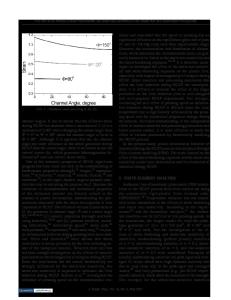Effect of Strain Rate on Plastic Flow in Zr-Based Metallic-Glass-Reinforced Porous Tungsten Matrix Composites
- PDF / 2,001,113 Bytes
- 6 Pages / 593.972 x 792 pts Page_size
- 32 Downloads / 352 Views
I.
INTRODUCTION
BULK metallic glasses (BMGs) have many promising properties such as high yield strength, hardness, rather low Young’s modulus, large elastic strain limit combined with relatively high fracture toughness, as well as good wear and corrosion resistance.[1–5] However, monolithic BMGs usually exhibit no plastic deformation after yielding during room-temperature deformation due to the formation of highly localized shear bands,[6–10] which significantly limits the range of applications as structural materials. The motivation to improve the ductility of those monolithic BMGs leads to the development of BMG-based composites.[11–15] The reinforced phases are expected to hinder the propagation of a single shear band within BMGs and seed the initiation of multiple shear bands throughout the specimens.[16–20] Conner et al. prepared the tungstenfiber/metallic-glass matrix composite with enhanced plasticity by the method of melt infiltration for the first time.[21] Zhang et al.[22] reported that the Zr-based metallic glass reinforced porous tungsten matrix composite by the same method exhibited excellent ductility. Xue et al.[23,24] also reported a new Zr-based metallicglass-reinforced porous tungsten matrix composite strengthened by hydrostatic extrusion with enhanced yield strength as compared to the as-cast composite under both quasi-static and dynamic compression, respectively. Y.F. XUE and H.W. CHENG, Lectors, and L. WANG, H.N. CAI, and F.C. WANG, Professors, are with the School of Materials Science and Engineering, Beijing Institute of Technology, Beijing 100081, P.R. China. Contact e-mail: [email protected] H.F. ZHANG and A.M. WANG, Professors, are with the Shenyang National Laboratory for Materials Science, Institute of Metal Research, Chinese Academy of Sciences, Shenyang 110016, P.R. China. Manuscript submitted September 16, 2010 Article published online June 9, 2011 METALLURGICAL AND MATERIALS TRANSACTIONS A
Despite the fact that BMGs and BMG-based composites were extensively studied for many years, the effect of strain rate on compressive flow stress of those materials has not been established in the literature. All kinds of positive strain rate sensitivity, no strain rate sensitivity, and negative strain rate sensitivity were found for BMGs, revealing that the variations of microstructure, chemical compositions, loading modes, sample geometry, and level of amorphization of metallic glasses significantly influence the mechanical behaviors of BMGs under different strain rates.[25–32] The strain rate sensitivity itself is a function of the composition, swaging, and, potentially, the differences in the microstructure and matrix composition as a result of differences in processing. For example, Lankford et al.[33,34] found that microstructural influences can significantly alter the dynamic deformation and failure of tungsten heavy alloys. For BMG-based composites, only a small amount of correlative information is available about the effect of strain rate on flow strength.[35,36] The deformation and fracture behaviors
Data Loading...











